Even if you are not confused about the choice between cross stitching and embroidery, you might be looking for a contrast to succeed in your crafty projects. Perhaps you want to grow your skills in both categories.
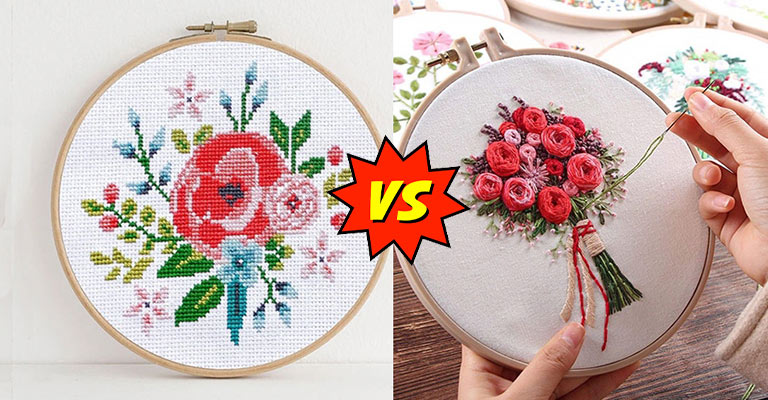
Then let us ensure that you are on the right web page. This comparative article will tell you the differences in detail. No matter you are a beginner or not, this will feed you the best.
Difference Between Cross Stitching and Embroidery
The differences between cross stitch and embroidery are a matter of common curiosity for many. Among all the needlecraft, these two are very significant. Here in this article, we will be discussing the defining characteristics of both. Are you there to jump downright?
Then let’s go! First, we will dwell on embroidery and its related affairs.
1. Embroidery
Embroidery means any type of embellishment stitched onto fabric. A creative mind looking for embellishing fabric with decorative patterns and designs and begets embroidered work.

(a) Patterns
Do you know the most common way to transfer a design to fabric? Well, it is embroidery. Not merely that, but you may feel free to use various stitches to fill in it!
(b) Stitches
You will have hundreds of different stitches and knots with lots of variations. Let us introduce you to some of the most common stitches. These are –
- Satin Stitch
- Chain Stitch
- Back Stitch
- Bullion Stitch
- Stem Stitch
- Herringbone Stitch
- French Knot
- Lazy Daisy, etc.
Or let’s say you want to try something uncommon such as roses. Then allow us to share a beautiful guideline on this:
(c) Techniques and Appearance
Surface embroidery is more dimensional and textured than cross stitch in terms of techniques and appearance. We can exemplify cast-on stitch, herringbone stitch, or pinwheel rose in this respect. These are more 3-dimensional. You are bound to get amazed at their uniqueness. Some of them illustrate a chain-like appearance and some flowers with leaves.
(d) Types of Embroidery Work
There are two types of embroidered work – embroidery by hand and embroidery by machine. Let us get them in detail!
Hand Embroidery:
You merely need thread, needle, sequin, beads, and buttons to get accomplished a hand embroidery project. It is the most common and most popular embroidery type. This technique includes freehand stitching that works on top of the fabric. You can either come up with a simple design or a complicated one along with several kinds of stitches.
One of the most popular hand-embroidery methods is painting or blending colors. Herein this technique, you have to mix colored threads for shading patterns. You will be excited to know that it leverages you to stitch a variety of designs using different kinds of fabrics. Overall, it helps you best to create some personalized crafts. As a creative person, you cannot but love creative freedom here.
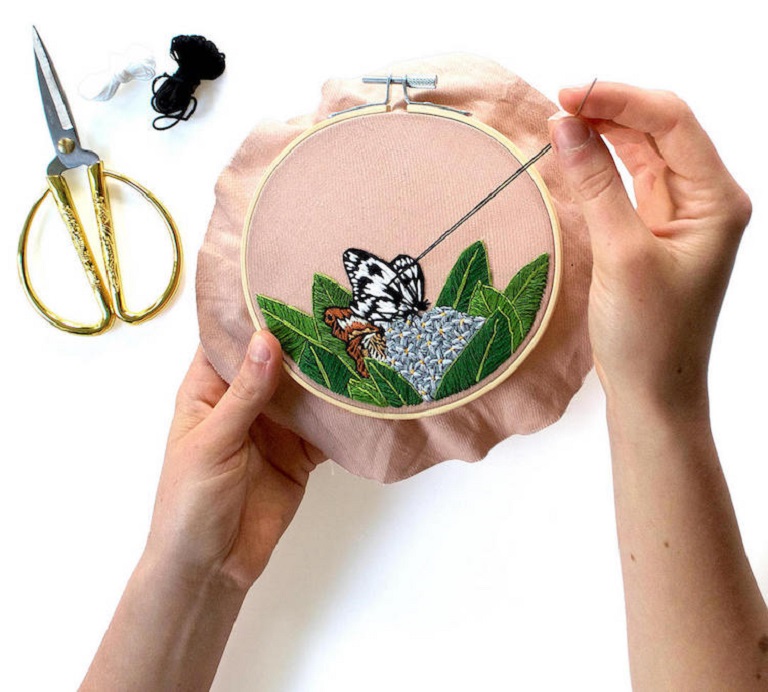
You should also be aware of its cons. For example, a hand embroidery project takes longer to accomplish. Compared to machine embroidery, it is much slower as a hand technique. So if you take it professionally, you may either need to compromise profit or maximize the manpower.
Allows us to imagine that you are really a beginner. So we suggest that it would help best if you employed embroidery hoops for quick learning. These will be handy for following a design more precisely. Also, it will minimize the amount of mess.
Please note one thing- it is not merely about freehand stitching. Apart from the freehand stitching of patterns, you can create any unique design through a fabric crayon you want! It will help you stitch your favorite pattern excellently by fixing the fabric in a stitching hoop.
Machine Embroidery:
It is an apt method for professionals and commercial producers since they aim to produce for the mass people. However, that doesn’t mean an individual should not learn or avoid this, not like that! This approach employs machines to embellish patterns on a limited number of fabrics. However, the cloth you choose must be compatible with the embroidery machine.
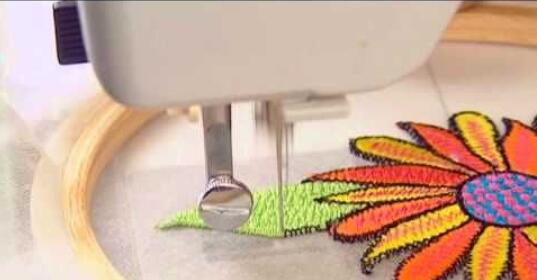
You will have sewing machines specifically for embroidery out there. You can make tremendous items such as cushion covers, tote bags, and different dresses. Do you know what the most thrilling matter is about this?
Apart from manual designing, you can use zigzag sewing patterns too!
Another good news for you- some of the advanced sewing machines allow computerized functions and pattern controlling through link stitch options. It not only eases but also fastens your stitching. However, these machines are apt for experts or highly professionals.
Got frustrated? No worries, there are a number of professional machines for beginners. As a beginner, you will find them pretty easy to use!
No matter if you have cotton or synthetic fabrics like polyester or even more challenging stuff like wool, quilting cotton, etc… you can stitch with embroidery machines. However, the embroidery machine you employ must be consistent with the fabric’s thread count. The best embroidery machines for 2022 are as follows:
- Brother SE1900
- Brother SE600
- Janome Memory Craft 9850
- Bernette b79
- Janome Memory Craft 14000
You may have a look to see how it works practically. Please go through the link below!
Compared to hand embroidery, you will find machine embroidery more expensive. Also, you will have to accept reduced creative freedom while stitching. For example, you can use exclusive materials like gold or bronze in hand stitching.
Now it’s time to dwell on cross stitch.
2. Cross Stitching
It is essentially a type of embroidery. However, you can differentiate it from embroidery as it needs ”counted needlework”. The people who do not know this confuses cross stitch with embroidery. Anyway, the counted needlework is most applicable on even-weave fabrics. The stiff Aida having visible holes can be a sheer example of even-weave fabric.
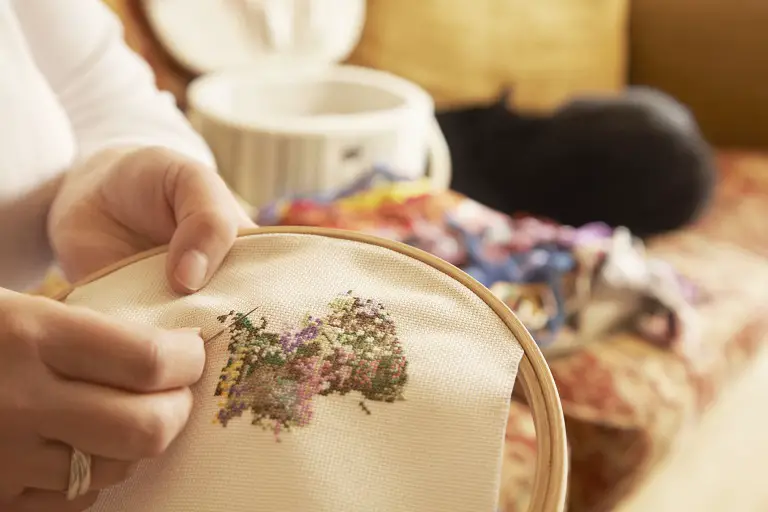
Do you know about the most suitable thread to apply in cross stitch? It is stranded cotton. Generally, we use 2 of the 6 strands. It helps you come up with a flat and neat finish.
You can use this method to create color gradients. Moreover, it allows you to mix color patterns. You can ensure this by using different shaded threads side by side.
(a) Stitches
Perhaps you are familiar with an X-shaped stitch. It is the most common cross stitch that forms a pattern on fabric. Unlike pop-up and dimensional patterns that emerge from embroidery, it uses several small Xs stitched together in squares of fabric. As a result, you will get the flat and neat pattern we stated above.
Else, half stitch and back stitch are the most frequently used stitches of cross stitch.
(b) Patterns
There is a way to know how many cross stitches or “squares” you need to make with each color. For this, you will have to follow a pattern. You will find the pattern as charted designs or hot iron transfers.
Nowadays, you will find charted designs as the most common designs. They are most fitting with the fabric featuring a natural grid. The Aida can be a perfect example of that. Why?
You can count the gridlines of the fabric. Besides, you can stitch the designs corresponding to the chart.
You can utilize hot iron transfers. It allows you to place directly even on solid and tightly woven fabric such as linens, tea towels, vintage pillowcases, etc.
(c) Techniques and Appearance
Usually, an item by cross-stitch lays flat onto the fabric, unlike hand embroidery. The fact is, in cross-stitching, you use different shades of color to create the effect of color blending. Thus, it results in a color gradient.
(d) Types
Mistakenly, people think that there is merely one way to do cross-stitching. No, besides small x-shaped stitches, you can create stitches in other ways to design patterns. The major types of cross stitches are as follows:
Stamped:
Every cross-stitch approach aims to succeed in complicated and intricate designs. That is why it is called a tricky style of stitching. The stamped cross stitch is the type of cross stitch that facilitates you to follow an easier path.
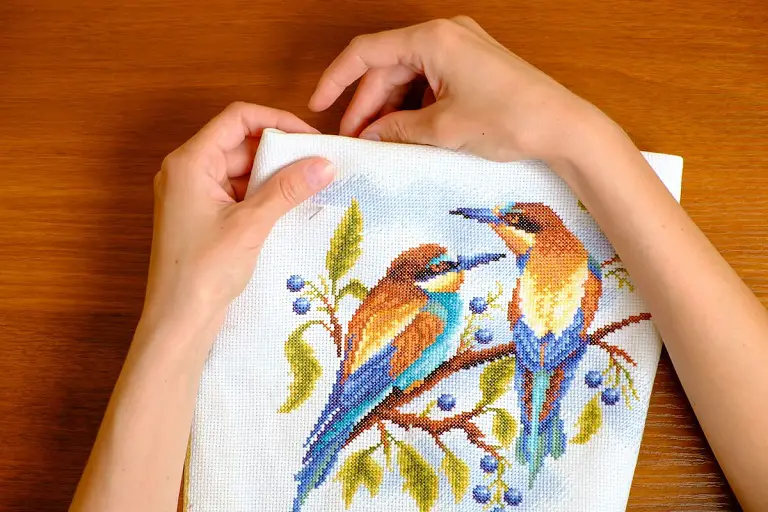
You merely need to print or stamp the chosen pattern onto the fabric. Then keep imitating. That’s it! In this method, the intended blueprint works as a guide for you. And it helps you avoid mess-ups.
Feel free to select any color that you want. This type of stitching allows you to establish creative color gradients in your project. For this, you need to manage fabric ink, and that should be washable. It will help you remove the ink end-to-end and get the desired product when you finish the entire project.
You will have stamped cross-stitch kit available in the market. Such a kit is an apt tool for this sort of project. This kit features simple-to-follow instructions. So it would undoubtedly be great for beginners.
Counted:
This cross-stitch technique teaches you to start from the center of the fabric and reach the end pattern by counting the number of stitches. So this is a self-explanatory stitching technique.
Herein this method, you will not have a blueprint to follow, instead, a blank fabric. But that doesn’t mean that you will not follow your intended design, alright! We recommend using a cross-stitch chart at the time of applying this technique. It is beautifully helpful in using colored grids.

Most importantly, the chart helps you come up with your desired design. And it depends on you whether you will use a color grid or count manually. No matter what you follow, the result is going to be the same. And remember, the cross-stitching kit quickens the process as you don’t need to shop for each supply distinctly.
Here we present the top cross-stitching kits of 2022 for beginners below:
- Caydo Full Range of Embroidery Starter Kit
- Nuberlic 3-Pack Cross-Stitch Starter Kit
- Wanderlust Cross Stitch Map
- Sea To Sky Modern Counted Cross-Stitch Kit
- Pusheen: A Cross-Stitch Kit
- Joy Sunday Magic Castle Embroidery Starter Kit
- Brightside Cross Stitch Kit
Is embroidery Harder Than Cross Stitch?
The fact is, embroidery and cross-stitch both are challenging. You see, surface embroidery includes various types of stitches. The more beautiful ones are more complicated. However, you can create fabulous designs with a little knowledge. So you don’t need to worry, better emphasize sound, gradual growth!
Let’s say you want to stitch a detailed image. In that case, you will find it more complicated to cross-stitch. However, pretty sure you will be relaxed to know that plenty of premade designs are available online. So even if you are a beginner, you can create an expert shot hopefully.
It takes additional time to finish a cross-stitch project. The reason is- you cannot cover as much surface area as fast as you in embroidery. Nonetheless, many people prefer cross-stitching as it is superbly meditative!
Which Type of Embroidery Should You Use?
It is indeed a beginner-type curiosity. Beginners are concerned about betterment and ease of application. Moreover, they see various stitching options and get overwhelmed.
This allows us to assume that you are a beginner, and by betterment, you mean ease of doing. Then we would like to say that cross stitch will be easier for you. You merely need to get familiar with the application of needles and thread well. Then you better go from simple to complex patterns. Gradually, you will learn to stitch with different materials like beads, sequins, or even gold.
Nonetheless, basic embroidery may seem easier to many. It is because every creative mind is different. So it would help best if you tried on your own. It will help you perceive which one is better for you. And if you are an expert, you better tackle both embroidery and cross-stitch at the same time. And yes, don’t forget to think about a project’s demand in this relation.
Pro-Tips
- Before all, it would help if you learned hand embroidery. It is like learning the basics of a guitar by finger instead of a guitar pick. On the contrary, learning to use a sewing machine takes a significant amount of time and effort. So you better regard it as a second priority.
- In embroidery, you can create mind-blowing patterns if you want within a limited means. This is the most exciting matter about it! You don’t need to invest in plenty of items to accomplish a project.
- And no matter if you go for cross-stitching or embroidery, in the beginning, simplicity should be your goal. Gradually, you may endeavor for more gorgeous projects. That will be wise.
- You had better start with basic cross and back stitches as a beginner.
- It would help if you employed a stitching hoop. What is the benefit? Well, this will help you avoid unforeseen issues.
- And as we suggested earlier, you should use an embroidery kit featuring a detailed instructions manual. The fact is, it is a vital suggestion of the experts in this industry. It comprises a fantastic guideline that is very comfortable for beginners. Apart from this, such a kit is cost-effective. And you will be able to master the skill faster!
Frequently Asked Questions and Answers
Question: Can you combine cross stitch and embroidery?
Answer: A combination of cross stitch and embroidery can be a good solution to make a complicated cross-stitch pattern. You can also use such a combination in adding a little bit of sparkle to a pattern
Question: What are the similarities and differences between stitching and embroidery?
Answer: Both are needlepoint projects, but they serve different purposes. While stitching aims to create a fabric structure, embroidery polishes what you have made through patterns.
Question: How many strands do you use for cross stitch?
Answer: Generally, while working on 14-count and 16-count Aida, the cross stitch employs two strands. These are usually of stranded cotton. In a project, it becomes necessary to mix the number of threads.
Question: Can I cross-stitch without a hoop?
Answer: Of course, you can! In that case, you will need to rely on the “sewing” method. Before pulling the thread, you have to stab the needle in and out to finish the project.
Question: What is the best thread for cross stitch?
Answer: Stranded cotton is the best thread for cross stitch. It is a combination of six strands. Here experts use loosely twisted thread. You have to use two of these strands.
Question: How many threads do you use for embroidery stitches?
Answer: Generally, embroiders use six strands in the needle at once for embroidery stitches in today’s embroidery. They especially maintain it in the backstitch.
The Ending Thoughts
The choice of stitching depends on the requirements of a project. Also, the vision a producer possesses matters here. You see, a cross-stitch is an excellent approach to border your crafts, whereas adding some bling with sequin and beads embroidery is handier. Or, it will be wise to go with embroidery if you want to achieve a pop-up and three-dimensional pattern.
So now you know both embroidery and cross-stitch are needlepoint projects to succeed in a thread embroidery effort. We wish you a stroke of good luck!
Leave a Reply